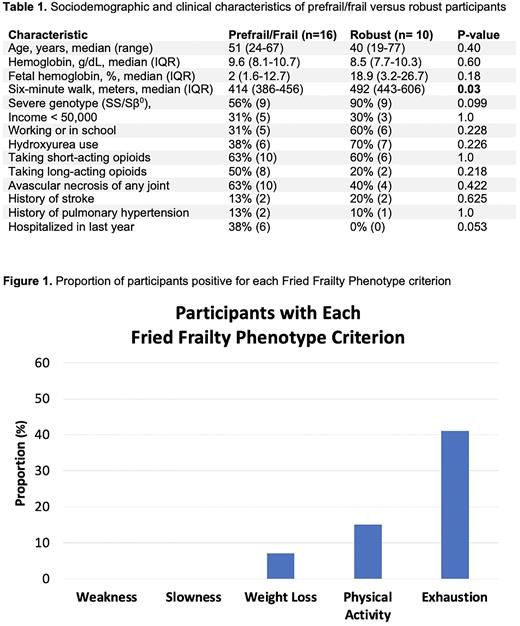Abstract
Background As individuals with sickle cell disease (SCD) age, they acquire both SCD and age-related complications early in life leading to premature functional decline. Chronologic age does not accurately represent health status. Frailty is a syndrome that frequently occurs with aging, characterized by decreased physiologic reserve and increased vulnerability to stressors. It leads to adverse outcomes such as loss of independence and death. Individuals with SCD experience stressors such as frequent hospitalizations for vaso-occlusive painful events and organ damage; however, frailty has not been defined in people with SCD. This study seeks to assess the feasibility of characterizing frailty in older adults with SCD using the Fried Frailty Phenotype (FP).
Methods We enrolled younger (age 18-39) and older (age ≥ 40 years) adults with SCD in a single-center cross-sectional study. Frailty was defined as the presence of ≥ 3 of the following criteria: unintentional weight loss (≥ 10 pounds in the last year), exhaustion (by 2-item questionnaire), weakness (seated grip strength < 27 kg for males and < 16 kg for females), slowness (usual gait speed ≤ 0.8 m/s), and low physical activity by questionnaire (energy expenditure < 383 kcal/week for men and < 270 kcal/week for women). Individuals with 1 or 2 criteria present were categorized as 'prefrail' and individuals with none of the criteria were categorized as 'robust'.
We summarized demographic, medical history, and scores for each FP criterion. Feasibility end points were the proportion of participants who completed all portions of the FP assessment, acceptability of the assessments, and adverse events. We described the characteristic of participants in each FP group.
Results We assessed FP at steady state in 28 participants. 93% (n=26) of participants had complete data (1 did not complete all surveys and 1 did not complete grip strength assessment both due to limited time in clinic). There were no adverse events related to performing FP. No participants reported that FP measures were difficult to understand or upsetting.
The mean age of all participants was 46.3 (range 19-77 years). The mean age was 28.8 (± 5.1) for younger adults and 54.6 (± 8.7) for older adults. Most (68%) were aged ≥ 40 years and female (71%). Most (57%) had HbSS, 32% had HbSC, 7% had HbSβ0-thalassemia, and 4% had HbSβ+-thalassemia.
Out of the 26 participants with complete data, 1 participant met criteria for being frail, 58% (n=15) were prefrail, and 38% (n=10) were robust.
The proportion of participants positive for each FP criterion is shown in Figure 1.
Out of the 27 participants who completed survey data, 7% (n=4) met criteria for weight loss.
Several (41%) participants met criteria for exhaustion with 11 participants reporting that they felt that "everything was an effort" and 3 participants reported that they also felt that they "could not get going" at least a moderate amount of the time.
The median grip strength was 30 kg (IQR 25-37) with median of 26 kg (IQR 21-32) for women and 53 kg (IQR 42-51) for men. No participants met criteria for weakness.
On usual gait speed assessment, the median gait speed was 1.17 m/s (IQR 1.02-1.22). No participants met criteria for slowness.
When we compared characteristics between prefrail/frail versus robust participants (Table 1), prefrail/frail participants had a significantly shorter six-minute walk distance (6MWD) (414 vs 492 meters; p=0.03) and had more participants hospitalized in the last year that approached significance (38% vs 0%; p=0.053). There was no difference in age, income, employment status, hemoglobin, hydroxyurea use, opioid use, history of avascular necrosis, or history of stroke.
Conclusion We demonstrated that measuring frailty using Fried Frailty Phenotype was feasible, acceptable, and safe in both younger and older adults with SCD. Most participants met criteria for being prefrail due to exhaustion. Prefrail/frail participants in our study had a shorter 6MWD and more participants hospitalized in the last year, which suggests there is clinical significance in identifying prefrail individuals with SCD. This may facilitate early initiation of interventions to prevent frailty. Regular exercise has been shown to reduce exhaustion and frailty in older adults in the general population. In future studies we will assess the prevalence of frailty in a large sample of adults with SCD and determine the appropriate cut points for each criterion.
Disclosures
Strouse:Takeda: Consultancy.
Author notes
Asterisk with author names denotes non-ASH members.


This feature is available to Subscribers Only
Sign In or Create an Account Close Modal